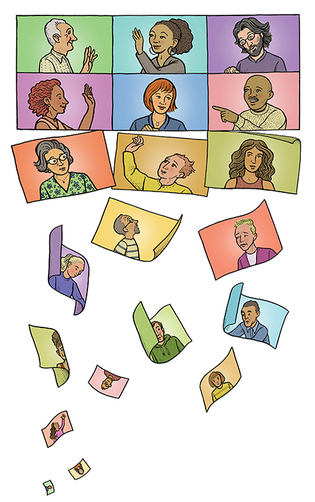
Gregory Nemec
Many have searched for silver linings amid the devastation of COVID-19: More time at home with family! Operation Warp Speed! For Marissa King, this past year has provided an unexpected research opportunity.
King, a professor of organizational behavior at the Yale School of Management, has long studied social networks. She has looked at how the shape and reach of people’s networks relate to the spread of social ailments—substance abuse, loneliness, and so on. As COVID-19 pushed hundreds of millions of people from their daily routines, as it severed us from friends and coworkers and collapsed the colorful experiences of life into the rectangle of our computer monitors, the world became, for King, one big laboratory: what does such an event do to our social networks? What does it do to us?
King’s recent survey showed that social networks, on average, have shrunk by 16 percent over the course of the pandemic. “But this reduction in size is due almost entirely to changes in men’s networks, which contracted by close to 30 percent,” King says. “Women’s networks hardly changed at all.”
This, she notes, has nothing to do with the time men and women commit to preserving connections. All evidence suggests that women have been more time-constrained than men during the pandemic. Rather, these differences are likely attributable to the distinct ways by which men and women maintain their networks. Men often connect through shared activities, like games or sports or happy hours; women tend to connect through conversation.
The pandemic has also foregrounded the social role of work in our lives. “Companies have tried to reinforce connections with monthly Zoom calls and random coffee chats,” King says. “But what’s interesting is how this draws attention to the fact that it’s really, really difficult to replicate normal human interaction in an online environment.”
Making these interactions meaningful and valuable, says King, requires a few things. Quantity is not one of them. “Having more social interactions isn’t the answer,” she says. Nor is overreliance on Zoom. People are actually more empathetic when they hear only a voice instead of having a video chat. Companies struggling to maintain social cohesion should think about structuring interactions that are intentional: watch a short video on art history and talk about it. These settings must also create feelings of mutual trust and safety, in large part by giving participants control over what they choose to disclose.
In the grand scheme, King says, COVID-19 has revealed the indispensability of something often taken for granted. “One thing that I hope comes out of the pandemic is that we realize just how important our social connections are,” she says. “I say this not only for our happiness and well-being, but also for our ability to come together as a society.”
 loading
loading